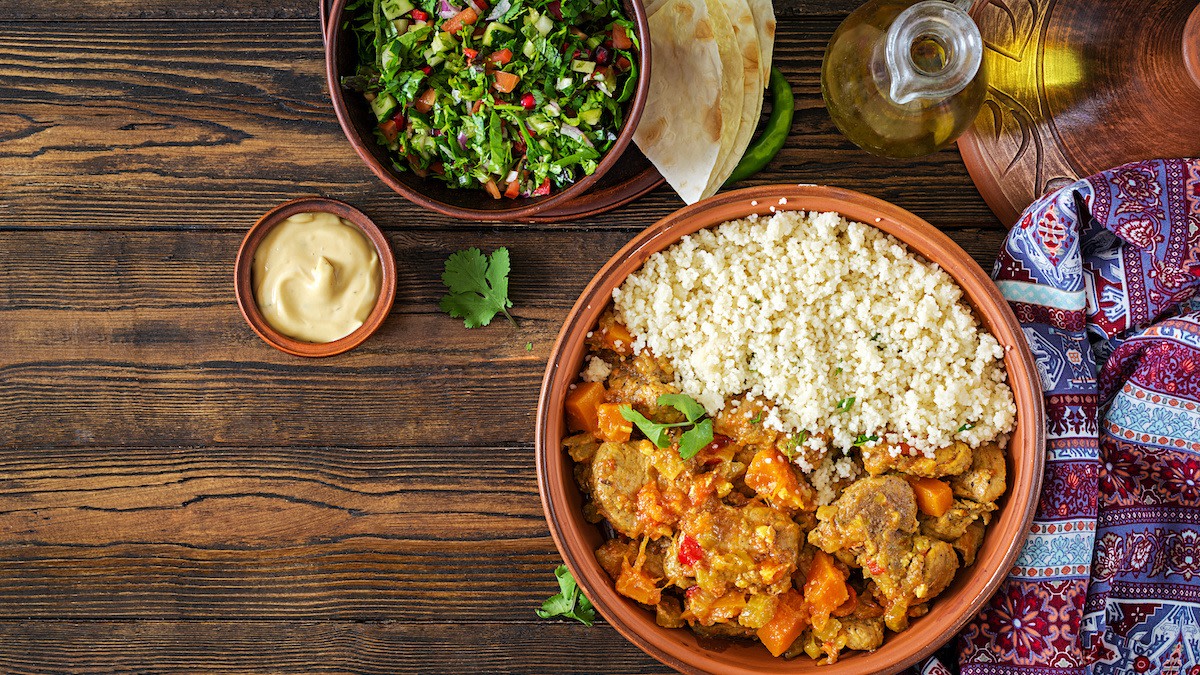15 Ingredients for Traditional North African Cooking
Written by MasterClass
Last updated: Jun 7, 2021 • 3 min read
North African cuisine includes the unique flavors of Morocco, Algeria, Tunisia, and Libya. While these countries each have their own culinary traditions, they also share many common ingredients. Here are some pantry basics you'll need to start cooking North African recipes.
Learn From the Best
3 Essential North African Condiments
Three basic condiments are particularly common in North African cookbooks:
- 1. Harissa: This spicy roasted red pepper paste, flavored with garlic and caraway, might be North African cuisine’s most famous export. You can find harissa prepackaged in jars or tubes, but it’s especially good if you make your own. Serve harissa with a Moroccan tagine—a North African meal cooked in a ceramic or clay pot—or use it to flavor a slow-cooked stew. Harissa also makes an excellent marinade for chicken.
- 2. Chermoula: Chermoula is a sauce you can use as both a marinade and a condiment. Popular throughout North Africa, chermoula varies regionally but often includes garlic, cilantro, ground chile pepper, cumin, black pepper, and preserved lemons or lemon juice. Traditionally used for seafood, chermoula goes with almost any meat.
- 3. Preserved lemons: Preserved lemons, made by fermenting whole lemons in lemon juice and salt, are a common addition to tagines, salads, and soups.
Common North African Grains, Legumes, and Nuts
Throughout North Africa, hearty stews are served with enough couscous to soak up their flavorful sauces, and beans and nuts are also common.
- 1. Couscous: Couscous is a North African type of pasta made from crushed durum wheat, semolina flour, and water shaped into small granules. First eaten by Berber people between the eleventh and thirteenth centuries, couscous was traditionally made by sprinkling water over hard-wheat flour and rolling the resultant dough into irregular one- to three-millimeter balls. This fresh pasta-like dough was then gently steamed as a carbohydrate-rich vessel for saucy meat and vegetable-based meals.
- 2. Wheat flatbread: Flatbread isn’t as popular in North Africa as it is in Middle Eastern cuisine, but Moroccans do have msemen, a rectangular flatbread served with mint tea or coffee and honey for breakfast. You’re more likely to encounter khobz, a leavened Moroccan bread with a disc shape, alongside savory dishes.
- 3. Chickpeas: Chickpeas form the base of the Moroccan soup harira, which is eaten to break the fast during Ramadan. (Harira can also be made with lentils.)
- 4. Fava beans: Fava beans are used in bessara, a Moroccan soup that also makes a fine dip, as well as tagines and salads.
- 5. Pistachios: Native to Afghanistan, pistachios are common in both sweet and savory North African dishes, from couscous to salads to pies.
- 6. Almonds: Like pistachios, almonds find their way into both tagines and desserts, like the shortbread cookies known as ghoriba. Toasted almonds and sugar make a sweet filling for the Moroccan flaky pie known as bestilla.
6 North African Herbs and Spices
Savory North African dishes often rely on make-ahead spice mixtures for seasoning.
- 1. Ras el Hanout: This North African spice blend means “head of the shop” and is popular in Algeria, Morocco, and Tunisia. It is used to flavor lamb, game, and other North African foods typically served with couscous. Ras el hanout can have about 30 different ingredients, including ground coriander, allspice, cumin, cardamom, cinnamon, fenugreek, grains of paradise, cayenne pepper, nutmeg, turmeric, paprika, ginger, rose petals, and oregano.
- 2. Dukkah: Dukkah, which means “to pound” in Arabic, is a spice mix of sea salt, sesame seeds, coriander seeds, cumin seeds, and hazelnuts. Dukkah is often served with bread and olive oil and is easy to make at home.
- 3. Cumin: Cumin pairs wonderfully with lamb. Use whole or freshly ground cumin seeds to season Moroccan lamb choua (steamed shoulders and ribs) or mechoui (barbecued lamb). Cumin is also a common flavoring in zaalouk, a Moroccan salad made of pounded eggplant (or zucchini) and tomato.
- 4. Grains of paradise: Grains of paradise are the glossy brown seeds of Aframomum melegueta, a reedy plant from the ginger family native to western Africa and the Gulf of Guinea. Woody, floral, and slightly spicy, grains of paradise are related to cardamom but often used in the manner of black peppercorns. Use them to season tagines.
- 5. Saffron: Saffron, the expensive golden stigma of the Crocus sativus flower, which originated in central Asia and was first brought to North Africa by Arabs in the seventh century. Moroccan farmers now grow the flowers, which you can use to flavor couscous, chicken, and beans. Learn more about saffron in our guide here.
- 6. Mint: Maghrebi mint tea, also known as Moroccan mint tea, is a hot beverage made with green tea leaves and fresh spearmint.
Want to Learn More About Cooking?
Become a better chef with the MasterClass Annual Membership. Gain access to exclusive video lessons taught by culinary masters, including Gabriela Cámara, Chef Thomas Keller, Massimo Bottura, Dominique Ansel, Gordon Ramsay, Alice Waters, and more.
